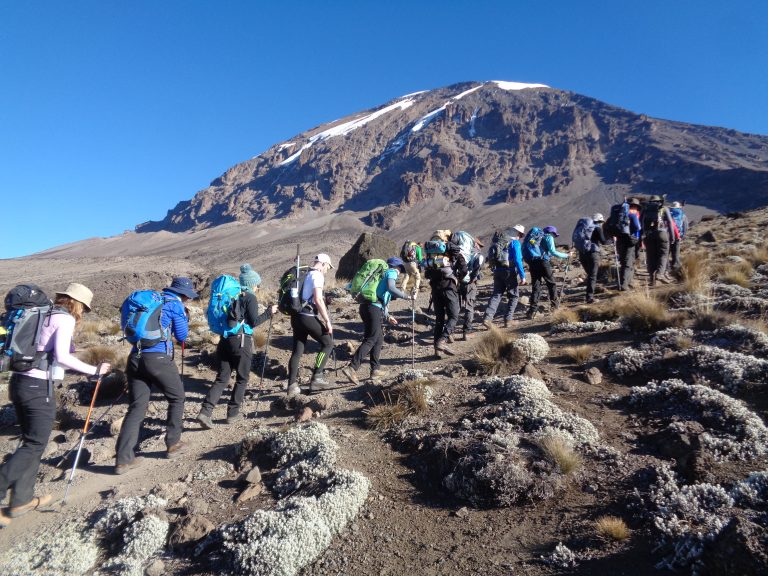Connecting with Nature on Mount Kilimanjaro: A Journey Beyond the Summit
Introduction
Mount Kilimanjaro is more than a climbing adventure; it’s a journey into some of the most pristine and awe-inspiring natural environments in the world. Rising majestically from the plains of Tanzania, this volcanic mountain offers climbers an unparalleled opportunity to connect with nature as they journey through diverse ecosystems, from lush rainforests to alpine deserts, all the way to its iconic snow-capped peak. Each stage of Kilimanjaro immerses climbers in unique landscapes and invites them to experience a deeper bond with the natural world.
The Journey Begins: Lush Rainforests and Wildlife
The journey to connect with nature on Mount Kilimanjaro starts at its base, where lush rainforests cover the lower slopes. These verdant forests are rich in biodiversity and home to countless species of flora and fauna, including monkeys, colorful birds, and rare plant species. The rainforest is often alive with the sounds of nature—chirping birds, rustling leaves, and the occasional call of colobus monkeys swinging through the trees. For many, this is the first point of connection with the mountain, offering a quiet and contemplative atmosphere that sets the tone for the climb ahead.
Climbers on Kilimanjaro quickly realize that each step reveals more of the mountain’s ecological wealth. The thick, humid forest air, vibrant vegetation, and presence of wildlife remind climbers of the life that thrives here, making this part of the trek a natural retreat in itself.
Ascending Through Moorlands: A Changing Landscape
As climbers leave the rainforest, they enter the moorland zone, where the landscape dramatically shifts. This zone is filled with towering heathers, strange-looking giant groundsels, and everlasting flowers, which create an otherworldly atmosphere. The open spaces and expansive views allow for a deeper connection with nature as climbers gain a more unobstructed view of the mountain and the surrounding valleys below.
The moorland zone also showcases Kilimanjaro’s unique adaptations to its environment, as plants and wildlife thrive in this less fertile, colder climate. In this space, climbers can feel the power of nature’s resilience, observing how life continues to flourish even in seemingly inhospitable conditions. This connection often reminds trekkers of their own strength and adaptability, inspiring them as they continue their climb.
The Alpine Desert: Embracing Solitude and Silence
Further up, the mountain transforms into an alpine desert, where vegetation becomes sparse, and the air grows thinner. This barren landscape, marked by rocky outcrops and vast open spaces, offers a stark and silent beauty that can be both humbling and meditative. For those seeking to connect with nature, the alpine desert provides a unique opportunity to experience solitude and silence, with only the mountain and the vast African sky as companions.
In this challenging environment, the simplicity of nature’s raw elements—wind, rock, and sky—gives climbers a sense of perspective. The silence encourages introspection, and many climbers find this part of the ascent to be a time of personal reflection, gaining a deeper understanding of both the mountain and themselves.
The Arctic Zone: Reaching Kilimanjaro’s Snow-Capped Summit
At the final stage, climbers enter the arctic zone, where temperatures plummet, and the landscape becomes a world of ice and snow. The stark, frozen beauty of Kilimanjaro’s summit contrasts sharply with the warmer, lush forests far below. Standing atop Uhuru Peak, climbers experience a profound connection with nature, surrounded by glaciers and panoramic views that stretch as far as the eye can see. Here, at the “Roof of Africa,” the mountain’s true grandeur is revealed.
The summit’s desolate beauty evokes a sense of awe and reverence, reinforcing the mountain’s power and timelessness. For many climbers, reaching Kilimanjaro’s peak is more than an achievement; it’s a transformative experience that leaves them feeling connected to something larger than themselves.
Connecting with Local Communities Along the Way
Beyond the natural landscapes, Kilimanjaro’s nearby local communities, such as the Chagga and Maasai people, play a significant role in deepening this connection. The Chagga people, who live on the mountain’s slopes, are known for their sustainable farming practices and cultural heritage, which are closely tied to the mountain’s resources. Interacting with these communities allows climbers to see how local people connect to the mountain as a source of life, history, and spirituality.
Participating in cultural tours or visiting Chagga villages provides climbers with a new perspective on Kilimanjaro. These experiences emphasize the mountain’s role as not only a physical landmark but also a cultural one that supports and enriches the lives of those who live near it.
Respecting Kilimanjaro’s Ecosystem: A Responsible Journey
To truly connect with nature on Kilimanjaro, climbers are encouraged to respect the mountain’s fragile ecosystem. This respect involves minimizing environmental impact, such as carrying out waste, avoiding harm to wildlife, and supporting sustainable tourism practices. Responsible climbers recognize the importance of preserving Kilimanjaro’s natural beauty, ensuring that future generations can experience the same powerful connection with the mountain.
The journey up Kilimanjaro is not just a physical feat; it’s an opportunity to witness and engage with the natural world in a profound way. From the lush rainforests to the icy summit, Kilimanjaro invites climbers to appreciate the diversity of life and the beauty of nature’s raw, untouched landscapes. Every step taken on this mountain is a reminder of nature’s resilience and a call to protect these sacred spaces for future explorers.
Connecting with nature on Mount Kilimanjaro is about embracing the mountain in all its forms—from the vibrant forests to the serene alpine deserts. It’s a journey that offers both physical and spiritual rewards, inspiring a newfound appreciation for the world’s natural wonders.


One Comment